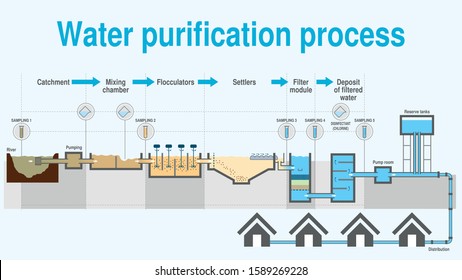The smart Trick of Water Treatment For Well Water That Nobody is Talking About
Table of ContentsNot known Facts About Water Treatment For Well WaterAll about Water Treatment For Well WaterThe 10-Second Trick For Water Treatment For Well WaterFascination About Water Treatment For Well Water
In this blog site, we will certainly cover the four types of water therapy plants, exactly how they work and also the lots of industrial applications of each type. Wastewater Therapy Plant (WWTP) Wastewater is the water that stems from water utilized in residential, agricultural, commercial as well as medical or transportation activities.on the other hand, comes from manufacturing, commercial and industrial tasks carried as well as has a totally different make-up than sewer water. How does it work? The first action in this water treatment plant is that the wastewater drains pipes to the plant with the assistance of gravity through the major sewer system.
In this stage, the water moves with the gravel chamber to remove any kind of grit. The water after that moves to the bar screens which remove large things.
This is after that removed from the container and disposed of at the dump. Following comes the sedimentation stage, also referred to as the main treatment. In this stage, the water moves to the primary settling tanks, likewise understood as pre-settling basins. These storage tanks have hoppers which are positioned in the base of the storage tank where water moves via.
Water Treatment For Well Water for Beginners
These working out containers enable the sludge to clear up and afterwards transfers to food digestion tanks. In the digestion tanks, the sludge is warmed as well as combined. Another crucial thing that occurs here is the manufacturing of biogas, which the wastewater therapy plants can recycle, in the production of electrical or thermal energy which is another massive advantage to the setting.
This makes it possible for the splitting up of water from the semi-solid sludge, whereas the continuing to be sludge undertakes the mechanical procedure once more for dewatering, that is securing as much water from the sludge as possible. The sludge after that left behind after the digestion and dewatering process is full, is finally taken care of in the dump.

The last step in wastewater therapy is inspection. This inspection includes checking the contamination degree of the water dealt with and seeing to it it abides by the greatest standards in order to be launched or reused for domestic or industrial functions. Applications: Most oil refineries or petrochemical as well as chemical markets produce a large quantity of wastewater as well as call for on-site wastewater therapy plants.
The wastewater right here streams via screens and also right into settlement containers that can obtain debris in huge amounts. It functions as a pre-treatment as mentioned above as it takes place prior to 3 even more aggressive phases- main, second and tertiary therapy. Main Therapy Throughout this stage, the wastewater relocates right into the clarifiers.
Some Ideas on Water Treatment For Well Water You Need To Know
It is the design of these tanks that result in working out, that is, the Continue natural solid issue collects at the bottom of the tank while the lighter issue drifts to the leading becoming simpler for removal. The organic issue that settles at the base is called a primary sludge blanket.

This RAS goes back right into the primary information storage tank and also the microorganisms in it assists in breaking down any organic issue in the sewage. When RAS has entirely undergone both the main and also second clarification basins constantly, i. e several times, it is turned into waste-activated sludge (WAS) (water treatment for well water). The WAS after that does not return to the primary explanation storage tank however instead relocates to the protected containers, also called aerobic sludge digesters.
The continuing to be sludge relocations to the dewatering facility that includes dewatering storage tanks where the plant utilizes belt presses to squeeze any continuing to be water out of the sludge. Tertiary Treatment Tertiary therapy follows the process of both primary and also second processes but likewise in enhancement includes mechanical and also photochemical procedures.
Water Treatment For Well Water - An Overview
Here the focus is offered to try this site physical strategies such as testing, sedimentation, purification, clarification etc. water treatment for well water. The objective of this is to get rid of as much solid physical matters as feasible prior to sending the effluent for more therapy. This phase entails the elimination of solid waste and also raw material. Below chemicals are added to damage down any type of solid and chemical browse around this web-site waste.
There are 2 types of materials- one is an anion one while the various other is a cation one. These former resins release hydroxyl ions which are adversely charged while the cation resins release hydrogen ions that are positively billed. The cation-exchange resins bring about conditioning of water, the anion-exchange lead to the removal of nitrate from wastewater as well as the combination of both the anion as well as cation exchange gets rid of practically every ionic pollutant existing in the feed water with a procedure called deionization.
Applications: Demineralization leads to the total removal of minerals from the water and is usually utilized in industries that call for water with high levels of pureness, for instance- makeup or feed water in high-pressure boilers, the food as well as drink market, as well as procedure streams used in the production of electronics. They are additionally utilized in sectors for the generation of heavy steam, power and air conditioning (water treatment for well water).
